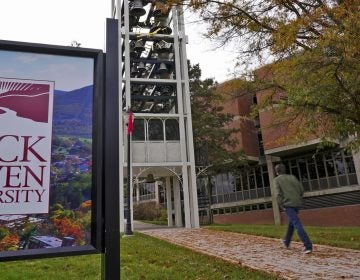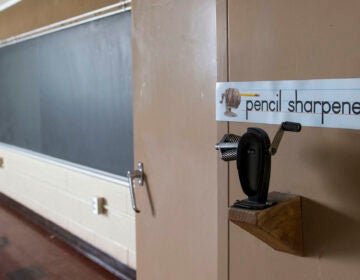Pa.’s state university system adopts strategy to address campus racism
Students who pushed officials to address campus racism said the board’s unanimous vote was heartening. Still, they’re withholding higher praise until they see results.

Daniel Greenstein, chancellor of the Pennsylvania State System of Higher Education, speaks at a press conference. (Commonwealth Media Services)
This story originally appeared on Spotlight PA.
___
Spotlight PA is an independent, non-partisan newsroom powered by The Philadelphia Inquirer in partnership with PennLive/The Patriot-News, TribLIVE/Pittsburgh Tribune-Review, and WITF Public Media. Sign up for our free newsletters.
Pennsylvania’s public university system has agreed on a strategy to address racism on its campuses by building a more diverse staff and curriculum after students of color spoke out about feeling unsafe and overlooked.
The 20-member Board of Governors voted April 15 to establish diversity, inclusion, and equity priorities by collecting data on university demographics and establishing resources for change.
“I kept thinking about all the graduates who could have benefited personally and professionally from greater faculty, staff, student, and curriculum diversity,” Denise Pearson, vice-chancellor and chief diversity, equity, and inclusion officer, told the board.
Chancellor Daniel Greenstein, who oversees the network of 14 universities known formally as the Pennsylvania State System of Higher Education, said in a letter to Sen. Art Haywood (D., Philadelphia) the plan will involve the creation of “precise goals, action steps, and evaluation measures.”
Haywood and students of color had pressed the system to take urgent action amid a national reckoning on race and in response to racist incidents at its schools. The lawmaker said Spotlight PA reporting on discrimination and bias faced by students inspired the push, dubbed the ENOUGH initiative.
While the system’s new framework is big on promises, it is currently light on specifics. Students who helped lead the initiative said the board’s unanimous vote was heartening but that they will hold higher praise until they see results.
“I was shocked in a good way,” said Zuri Redmond, a student at East Stroudsburg University. “I’ll be more satisfied once everything is in place.”
As Spotlight PA reported last year, students of color across the system — including at Shippensburg, Indiana, and Bloomsburg — have been subjected to racist incidents and racist social media posts from fellow students. At Millersville University in Lancaster County, two students posted a photo of themselves wearing charcoal facial masks as blackface.
And during meetings with system leadership, Haywood said he “raised several examples with the chancellor of [students] being called the N-word and Zoom bombed with open racial epithets.”
Administrators typically reacted to such incidents with soul-searching but little substance, students previously told Spotlight PA.
“Nothing usually happens,” Redmond added. “The school gives a sort-of-kind-of apology and says ‘We’ll look into this,’ and the students that do these things are not punished. They’re not penalized.”
Haywood also said there needs to be accountability.
“Each university president … complained [to me] about their ability to address students who were involved in racial harassment, [saying that harassment] was consistently characterized as protected free speech,” Haywood said. “And the presidents feel like their hands are tied because they’re not getting support from lawyers.”
Per a public-facing dashboard, “underrepresented minorities” — representing “Hispanic/Latinos, African Americans, Native Americans, Native Hawaiian/Pacific Islanders, and those of two or more races” — accounted for just 10% of the system’s faculty and staff in 2019.
That same year, the most recent with data available, “underrepresented minority” students made up roughly 20% of the system’s enrolled undergrads and grads. (International students are in a separate category.) Nationwide, students of color represent nearly half of undergrad enrollments and a third of graduate school enrollments.
Hispanic people, who are among the fastest-growing college cohorts in the country, made up just 6% of the system’s enrollments in 2019.
Greenstein said the low number of faculty members of color can be traced, in part, to the system’s lack of graduate programs and sole research university, Indiana University of Pennsylvania. Most professors go straight from graduate school to teaching, creating an in-house pipeline of talent, he said, and recruiting from elsewhere is complicated.
“Faculty and staff, frankly, arrive in, you know, rural regions that are not super diverse, and so we need to provide more mentoring and support,” he said.
The framework contained in Greenstein’s letter addresses these disparities with commitments to hire more faculty and staff of color, and nurture and retain more students of color, which Haywood lauded.
“This has never been done before after decades of complaints from African American students,” Haywood said.
Students of color who already attend the system’s schools are encouraged to use a new bias and discrimination reporting tool. There are hurdles with this kind of self-reporting, though, with incidents of bias historically underreported.
Haywood said there are ongoing conversations between the Pennsylvania Office of Attorney General and the state system “about how they defend [or support] school presidents when they want to take more aggressive action.”
The success of the ongoing effort to improve the student experience and campus environments will be gauged, in part, by surveys of faculty and staff, Greenstein told Spotlight PA.
Measuring the changes in faculty demographics, on the other hand, is much more straightforward.
In almost exclusively white Tioga County, Mansfield University counts just six “underrepresented minority” faculty — four Hispanic, one Black, and one multiracial — for 1,663 students. That’s a 277:1 ratio.
At the moment, the state system is operating at a $52 million deficit and facing other longstanding financial challenges. It’s planning a major redesign — potentially merging six colleges into two regional schools.
Enrollment also dropped 18% overall between 2010 and 2018, and the pandemic will likely only make matters worse.
Redmond, of East Stroudsburg University, said as more students reconsider in-person options after a year of profound disruption, universities will have to work even harder to bring them in and bring them back.
“A lot more people my age are considering doing online school now because it’s cheaper,” Redmond explained, “and why go to a campus that doesn’t support people that look like you or a campus that has these kinds of [racist incidents] going on?”
Haywood said the state legislature, during the ongoing redesign of the system, has an opportunity to put more funding behind diversity, equity, and inclusion initiatives.
Greenstein said of the system’s current push, “We’re not necessarily out in front or in the lead here, but I think this [plan] is a huge step for us.”
 WHILE YOU’RE HERE… If you learned something from this story, pay it forward and become a member of Spotlight PA so someone else can in the future at spotlightpa.org/donate. Spotlight PA is funded by foundations and readers like you who are committed to accountability journalism that gets results.
WHILE YOU’RE HERE… If you learned something from this story, pay it forward and become a member of Spotlight PA so someone else can in the future at spotlightpa.org/donate. Spotlight PA is funded by foundations and readers like you who are committed to accountability journalism that gets results.
WHYY is your source for fact-based, in-depth journalism and information. As a nonprofit organization, we rely on financial support from readers like you. Please give today.






